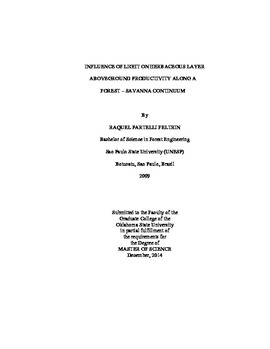| dc.contributor.advisor | Will, Rodney E. | |
| dc.contributor.author | Partelli Feltrin, Raquel | |
| dc.date.accessioned | 2016-04-15T21:49:34Z | |
| dc.date.available | 2016-04-15T21:49:34Z | |
| dc.date.issued | 2014-12-01 | |
| dc.identifier.uri | https://hdl.handle.net/11244/33442 | |
| dc.description.abstract | The herbaceous layer in forest ecosystems is often ignored because of its small stature and contribution to the overall ecosystem biomass. Unlike forests, the herbaceous layer in savanna ecosystems is more noticeable, however little is known about the factors that control the productivity in this layer, especially the influence of light. The study was conducted at Pushmataha Forest Habitat Research Area in southeastern Oklahoma that have units with different overstory densities due to previous mechanical treatments and sustained differences in fire return interval. The goal of this study was to determine relationship between light availability and intercepted photosynthetically active radiation (IPAR) on herbaceous productivity along a forest-savanna continuum. IPAR by the overstory and herbaceous plants was measured multiple times during the 2013 growing season. Herbaceous aboveground net primary production (ANPP) was measured at the end of the 2013 growing season by clipping and weighing biomass components (grass, forb, legume, woody, sedge, and litter). Overstory and herbaceous IPAR showed two distinct trends over the growing season. Forested treatments had a substantial increase in the beginning of the growing season related to canopy development of the deciduous trees. In savanna treatments, the overstory trend of IPAR was more consistent over the year. Herbaceous IPAR in forested units had a trend that was more consistent, while in savanna treatments there was a substantial increase at the onset of the growing season due to the development of the dense herbaceous layer. In general, all the categories of herbaceous ANPP were positively correlated with the light availability. The total herbaceous ANPP had a positive relationship with PAR available and IPAR by the understory. However IPAR by the understory was a better predictor for herbaceous ANPP (r2=0.65). The ability of plants to use IPAR to produce biomass in the herbaceous layer in forest and savanna ecosystems was similar regardless of overstory density and treatment. These results indicate that the pattern of IPAR by overstory and herbaceous layer are dependent of the species and the density of plants. However the ability of plants to use PAR to produce biomass was consistent across a wide range of conditions. | |
| dc.format | application/pdf | |
| dc.language | en_US | |
| dc.publisher | Oklahoma State University | |
| dc.rights | Copyright is held by the author who has granted the Oklahoma State University Library the non-exclusive right to share this material in its institutional repository. Contact Digital Library Services at lib-dls@okstate.edu or 405-744-9161 for the permission policy on the use, reproduction or distribution of this material. | |
| dc.title | Influence of Light on Herbaceous Layer Aboveground Productivity along a Forest - Savanna Continuum | |
| dc.type | text | |
| dc.contributor.committeeMember | Wilson, Duncan S. | |
| dc.contributor.committeeMember | Hennessey, Thomas C. | |
| osu.filename | PARTELLIFELTRIN_okstate_0664M_13748.pdf | |
| osu.accesstype | Open Access | |
| dc.description.department | Natural Resources and Ecology Management | |
| dc.type.genre | Thesis | |
